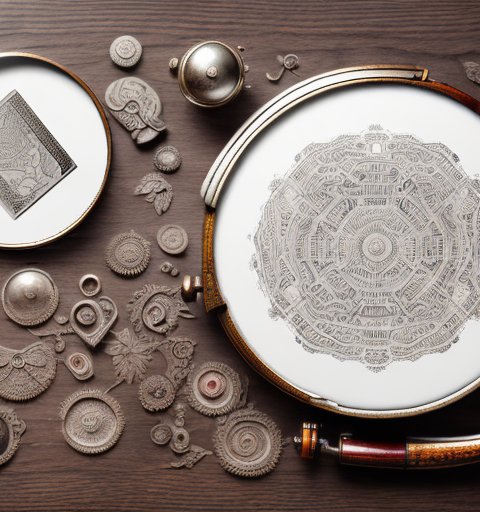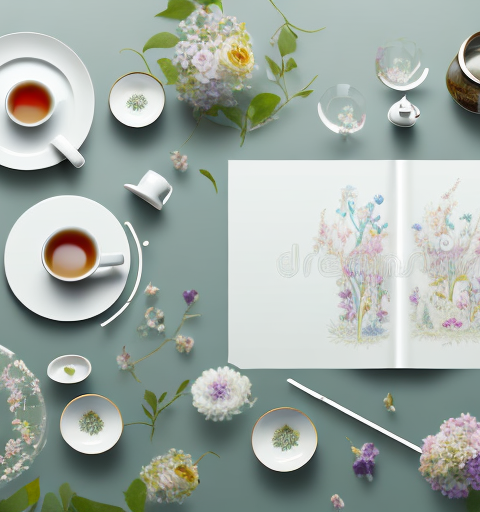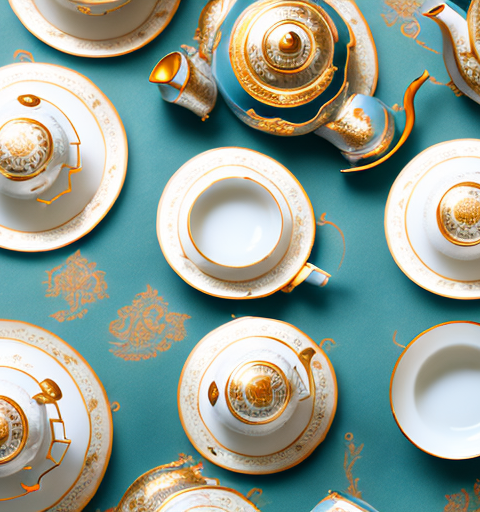If you are a tea enthusiast, you may find yourself wondering whether you can use your ceramic teapot for brewing tea blends with a balanced and harmonious taste. The answer is a resounding yes! Ceramic teapots are an excellent choice for brewing tea due to their unique properties and ability to enhance the flavor of the tea. In this article, we will explore the importance of choosing the right teapot for brewing tea, the versatility of ceramic teapots in enhancing tea flavors, the benefits of brewing tea blends in a ceramic teapot, and how ceramic teapots preserve the aroma and taste of tea blends. We will also discuss factors to consider when using a ceramic teapot for tea brewing, the science behind achieving balanced and harmonious tea flavors, and provide a step-by-step guide and tips for maximizing flavor extraction in your ceramic teapot. Lastly, we will explore different types of tea blends for optimal flavor in a ceramic teapot, understand the impact of temperature and time on tea brewing, and highlight common mistakes to avoid when using a ceramic teapot for brewing tea blends. We will conclude by discussing the importance of cleaning and maintaining your ceramic teapot for long-lasting taste quality.
Understanding the Importance of Choosing the Right Teapot for Brewing Tea
When it comes to brewing tea blends, the teapot you use plays a significant role in the final flavor and overall tea-drinking experience. Each type of teapot material has its unique characteristics and properties that can affect the taste of the tea. Ceramic teapots, in particular, are a popular choice among tea enthusiasts due to their ability to retain heat evenly and gradually, which allows for a more controlled and balanced extraction of flavors from the tea leaves. Additionally, ceramic teapots are known for their elegant and aesthetic appeal, making them a visually pleasing addition to any tea session. When choosing a ceramic teapot for brewing tea blends, it is essential to consider factors such as the size, shape, and thickness of the teapot, as these elements can impact the brewing process and the resulting taste of the tea.
Another important factor to consider when choosing a teapot for brewing tea is the type of tea you plan to brew. Different teas require different brewing temperatures and steeping times, and certain teapots are better suited for specific types of tea. For example, a glass teapot is ideal for brewing delicate green or white teas, as it allows you to visually appreciate the color and clarity of the tea liquor. On the other hand, a cast iron teapot is well-suited for brewing robust black teas, as it retains heat exceptionally well and helps to enhance the bold flavors of the tea.
In addition to the material and type of teapot, the design and functionality of the teapot should also be taken into consideration. Some teapots come with built-in infusers or strainers, which can make the brewing process more convenient and efficient. Others may have a spout designed to prevent drips and spills, ensuring a mess-free pouring experience. It is important to choose a teapot that not only meets your brewing needs but also aligns with your personal preferences and style.
The Versatility of Ceramic Teapots in Enhancing Tea Flavors
One of the remarkable qualities of ceramic teapots is their versatility in enhancing the flavors of different tea blends. Whether you prefer delicate white teas, robust black teas, or fragrant green teas, a ceramic teapot can elevate their taste profiles to new heights. The porous nature of ceramic allows for the gradual release of heat and moisture during the brewing process, which promotes a more balanced and nuanced flavor extraction. The heat retention of ceramic teapots also ensures that the tea remains at a consistent temperature throughout the brewing time, allowing the tea leaves to unfurl and release their full flavor potential. Moreover, the smooth surface of ceramic teapots prevents any unwanted interactions between the teapot and the tea, ensuring that the pure essence of the tea blend is preserved.
In addition to their flavor-enhancing qualities, ceramic teapots are also known for their aesthetic appeal. The wide range of colors, patterns, and designs available in ceramic teapots allows tea enthusiasts to choose a teapot that reflects their personal style and adds a touch of elegance to their tea-drinking experience. Whether you prefer a classic, minimalist design or a vibrant, intricate pattern, there is a ceramic teapot to suit every taste. The beauty of ceramic teapots not only enhances the visual enjoyment of tea preparation but also makes them a delightful addition to any tea collection or table setting.
Exploring the Benefits of Brewing Tea Blends in a Ceramic Teapot
Brewing tea blends in a ceramic teapot offers a multitude of benefits that contribute to a balanced and harmonious taste. Firstly, ceramic teapots have excellent heat insulation properties, which means that the tea will stay hot for a more extended period – perfect for enjoying multiple cups of tea. Secondly, the porous nature of ceramic allows for optimal moisture retention, keeping the tea leaves moist throughout the brewing process. This has a significant impact on flavor extraction, as it ensures that the tea leaves have ample time to release their flavors and aromas. Additionally, ceramic teapots offer a smooth and non-reactive surface that does not alter the taste of the tea, ensuring a pure and unadulterated tea experience.
How Ceramic Teapots Preserve the Aroma and Taste of Tea Blends
Ceramic teapots excel in preserving the aroma and taste of tea blends due to their ability to retain heat and moisture. The gradual and even heat distribution in ceramic teapots allows for a gentle extraction of flavors from the tea leaves, resulting in a well-balanced and aromatic brew. The moisture retention properties of ceramic teapots ensure that the tea leaves stay hydrated and release their natural fragrances throughout the brewing process. This preservation of aroma and taste is essential for achieving a harmonious and pleasurable tea-drinking experience, as it allows you to savor the delicate nuances and complexities of the tea blend.
Factors to Consider When Using a Ceramic Teapot for Tea Brewing
To achieve the best possible flavor when using a ceramic teapot for tea brewing, it is important to consider several factors. Firstly, the type of tea you are brewing plays a significant role in determining the optimal brewing temperature and brewing time. Different types of teas require specific temperatures to unlock their full flavors, and over or under brewing can result in a less enjoyable cup of tea. It is recommended to refer to the brewing instructions provided with your tea blend or conduct some research to understand the ideal parameters for brewing that particular type of tea. Additionally, the size of the teapot relative to the amount of tea leaves used should be considered. Too much or too little tea leaves in relation to the teapot’s size can affect the flavor concentration of the brewed tea. Experimenting with different tea-to-water ratios is a great way to find the perfect balance for your preferred taste.
The Science Behind Achieving Balanced and Harmonious Tea Flavors
Achieving balanced and harmonious tea flavors is both an art and a science. Understanding the science behind tea brewing can help you master the art of creating the perfect cup of tea. The flavor of tea is largely influenced by compounds such as tannins, caffeine, and essential oils that are present in the tea leaves. The proper extraction of these compounds is essential for achieving a well-rounded and pleasing taste. The temperature and time of the brewing process are critical factors that impact the extraction. Higher temperatures generally result in a stronger, more robust flavor, while lower temperatures lend a more delicate taste. Similarly, longer brewing times lead to stronger infusions, while shorter times produce lighter, more subtle flavors. It is essential to strike a balance between these factors to extract the desired flavors without overpowering or underwhelming the taste buds.
Step-by-Step Guide to Brewing Tea Blends in a Ceramic Teapot
To help you achieve a balanced and harmonious cup of tea using your ceramic teapot, follow this step-by-step guide:1. Start by preheating your teapot – pour hot water into the empty teapot and let it sit for a few minutes, then discard the water.2. Measure the desired amount of tea leaves according to the instructions provided for your specific tea blend or your personal taste preference.3. Boil fresh water, and once it reaches the recommended temperature for your tea, pour it into the teapot over the tea leaves.4. Allow the tea to steep for the recommended brewing time, usually between 2 to 5 minutes.5. Once the brewing time is complete, pour the tea into your cups, ensuring an equal distribution of flavors.6. Enjoy your cup of tea while it is still hot, savoring the balanced and harmonious flavors you have created.By following this guide, you will be able to brew tea blends in your ceramic teapot to perfection, ensuring a delightful tea-drinking experience.
Tips for Maximizing the Flavor Extraction in Your Ceramic Teapot
To maximize the flavor extraction in your ceramic teapot, consider the following tips:1. Use high-quality tea leaves – the better the quality of the tea leaves, the more flavorsome your brew will be.2. Experiment with different brewing parameters – such as water temperature, brewing time, and tea-to-water ratio – to find your preferred flavor intensity.3. Avoid using boiling water for delicate tea blends – high temperatures can scorch the leaves and result in a bitter or astringent taste.4. Clean your teapot regularly – to prevent the buildup of residues that could impact the flavor of future brews.By implementing these tips, you can further enhance the flavor extraction in your ceramic teapot, ensuring a truly enjoyable cup of tea every time.
Enhancing Your Tea Experience with a Properly Brewed Ceramic Teapot
Brewing tea blends in a ceramic teapot not only contributes to a balanced and harmonious taste but also enhances your overall tea-drinking experience. The aesthetic appeal of ceramic teapots, with their elegant designs and beautiful craftsmanship, adds a touch of elegance and sophistication to any tea session. The gradual and controlled heat distribution in ceramic teapots allows you to enjoy each sip of tea at the optimal temperature, enhancing the flavors and aromas of the tea blend. Additionally, the ability of ceramic teapots to preserve the natural taste and aroma of the tea leaves ensures that you can fully appreciate the nuances and complexities of the tea. With a properly brewed ceramic teapot, you can elevate your tea experience to new heights and indulge in the pleasures of a truly delightful cup of tea.
Exploring Different Types of Tea Blends for Optimal Flavor in a Ceramic Teapot
When it comes to brewing tea blends in a ceramic teapot, the possibilities are endless. Whether you prefer the delicate and floral notes of white tea, the bold and robust flavors of black tea, or the refreshing and grassy taste of green tea, ceramic teapots can enhance the flavors of each blend to perfection. Experimenting with different types of tea blends allows you to explore a wide spectrum of flavors and aromas, all enhanced by the unique properties of ceramic teapots. From exotic herbal infusions to traditional oolong teas, the world of tea is rich with options for creating an optimal flavor experience in your ceramic teapot. Don’t be afraid to venture into uncharted tea territories and discover your new favorite blend.
Understanding the Impact of Temperature and Time on Tea Brewing in a Ceramic Teapot
Temperature and time are two crucial factors that have a significant impact on tea brewing in a ceramic teapot. The temperature at which you brew your tea determines the extraction rate of flavors from the tea leaves. Different types of teas require different temperatures to achieve their optimal flavor profiles. For example, black tea typically brews best at a higher temperature, around 95°C (203°F), while green tea is often brewed at a lower temperature, around 80°C (176°F). It is important to follow the recommended brewing temperatures for each specific tea blend to extract the desired flavors. The brewing time also plays an important role in flavor extraction. While some tea blends benefit from a longer brewing time to fully develop their flavors, others require a shorter brewing time to prevent the extraction of undesirable compounds. It is crucial to find the right balance between temperature and time to create a perfectly brewed cup of tea in your ceramic teapot.
Common Mistakes to Avoid When Using a Ceramic Teapot for Brewing Tea Blends
When using a ceramic teapot for brewing tea blends, it is important to avoid certain common mistakes that can negatively impact the taste and overall tea experience. One common mistake is using boiling water for delicate teas such as green or white teas. Boiling water can scorch the delicate leaves and result in a bitter or astringent taste. It is best to use water that is slightly below boiling temperature for these types of tea blends. Another mistake to avoid is oversteeping the tea leaves. Leaving the tea leaves in the teapot for too long can lead to a bitter or strong brew. It is important to follow the recommended brewing time for each tea blend and adjust it to your personal taste preference. Lastly, neglecting to clean and maintain your ceramic teapot can also impact the taste of future brews. Residual flavors and residues can accumulate over time, leading to off-flavors in your tea. Regular cleaning and proper maintenance of your ceramic teapot will help ensure that each cup of tea is clean and full of flavor.
Cleaning and Maintaining Your Ceramic Teapot for Long-Lasting Taste Quality
To maintain the long-lasting taste quality of your ceramic teapot, it is essential to clean and care for it regularly. After each use, rinse the teapot with warm water to remove any leftover tea or residue. Avoid using detergents or abrasive cleaning materials, as they can leave behind unwanted flavors or scratches on the surface of the teapot. If stubborn stains persist, a gentle scrub with a non-abrasive sponge or a mixture of baking soda and water can help remove them. It is also beneficial to establish a routine for descaling your teapot to remove any mineral deposits. Simply fill the teapot with equal parts water and white vinegar, let it sit overnight, and rinse thoroughly the next day. Proper storage of your ceramic teapot is equally important. Make sure to dry it thoroughly after each use and store it in a clean and dry area away from direct sunlight or extreme temperatures. By following these cleaning and maintenance practices, you can ensure that your ceramic teapot retains its taste quality and serves you well in countless tea sessions to come.
In conclusion, using a ceramic teapot for brewing tea blends can indeed result in a balanced and harmonious taste experience. The unique properties of ceramic teapots, such as their heat retention and gentle flavor extraction, make them an ideal choice for tea enthusiasts seeking to enhance the flavors of their favorite blends. By carefully selecting a suitable teapot, understanding the science of tea brewing, and following proper brewing techniques, you can maximize the flavor extraction and create a truly delightful cup of tea. With regular cleaning and maintenance, your ceramic teapot will continue to serve as a faithful companion in your tea journey, preserving the taste and aroma of your preferred tea blends. So go ahead, brew a cup of tea in your ceramic teapot, and embark on a flavorful adventure that will satisfy your tea cravings and elevate your tea-drinking experience.






